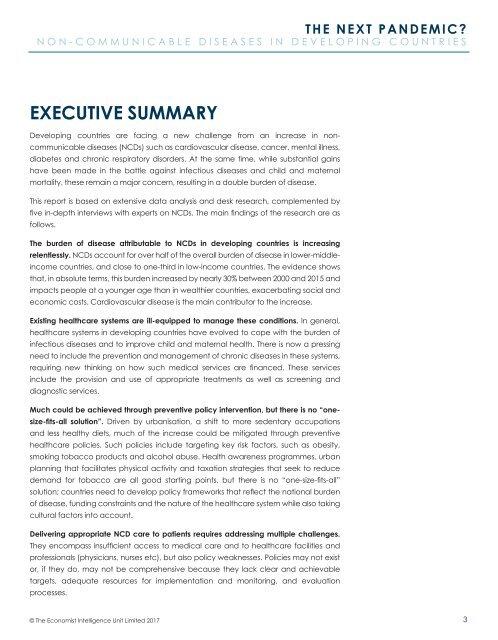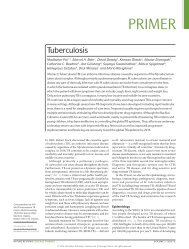THE NEXT PANDEMIC?
The_next_pandemic
The_next_pandemic
Create successful ePaper yourself
Turn your PDF publications into a flip-book with our unique Google optimized e-Paper software.
<strong>THE</strong> <strong>NEXT</strong> <strong>PANDEMIC</strong>?<br />
NON-COMMUNICABLE DISEASES IN DEVELOPING COUNTRIES<br />
EXECUTIVE SUMMARY<br />
Developing countries are facing a new challenge from an increase in noncommunicable<br />
diseases (NCDs) such as cardiovascular disease, cancer, mental illness,<br />
diabetes and chronic respiratory disorders. At the same time, while substantial gains<br />
have been made in the battle against infectious diseases and child and maternal<br />
mortality, these remain a major concern, resulting in a double burden of disease.<br />
This report is based on extensive data analysis and desk research, complemented by<br />
five in-depth interviews with experts on NCDs. The main findings of the research are as<br />
follows.<br />
The burden of disease attributable to NCDs in developing countries is increasing<br />
relentlessly. NCDs account for over half of the overall burden of disease in lower-middleincome<br />
countries, and close to one-third in low-income countries. The evidence shows<br />
that, in absolute terms, this burden increased by nearly 30% between 2000 and 2015 and<br />
impacts people at a younger age than in wealthier countries, exacerbating social and<br />
economic costs. Cardiovascular disease is the main contributor to the increase.<br />
Existing healthcare systems are ill-equipped to manage these conditions. In general,<br />
healthcare systems in developing countries have evolved to cope with the burden of<br />
infectious diseases and to improve child and maternal health. There is now a pressing<br />
need to include the prevention and management of chronic diseases in these systems,<br />
requiring new thinking on how such medical services are financed. These services<br />
include the provision and use of appropriate treatments as well as screening and<br />
diagnostic services.<br />
Much could be achieved through preventive policy intervention, but there is no “onesize-fits-all<br />
solution”. Driven by urbanisation, a shift to more sedentary occupations<br />
and less healthy diets, much of the increase could be mitigated through preventive<br />
healthcare policies. Such policies include targeting key risk factors, such as obesity,<br />
smoking tobacco products and alcohol abuse. Health awareness programmes, urban<br />
planning that facilitates physical activity and taxation strategies that seek to reduce<br />
demand for tobacco are all good starting points, but there is no “one-size-fits-all”<br />
solution; countries need to develop policy frameworks that reflect the national burden<br />
of disease, funding constraints and the nature of the healthcare system while also taking<br />
cultural factors into account.<br />
Delivering appropriate NCD care to patients requires addressing multiple challenges.<br />
They encompass insufficient access to medical care and to healthcare facilities and<br />
professionals (physicians, nurses etc), but also policy weaknesses. Policies may not exist<br />
or, if they do, may not be comprehensive because they lack clear and achievable<br />
targets, adequate resources for implementation and monitoring, and evaluation<br />
processes.<br />
© The Economist Intelligence Unit Limited 2017<br />
3




